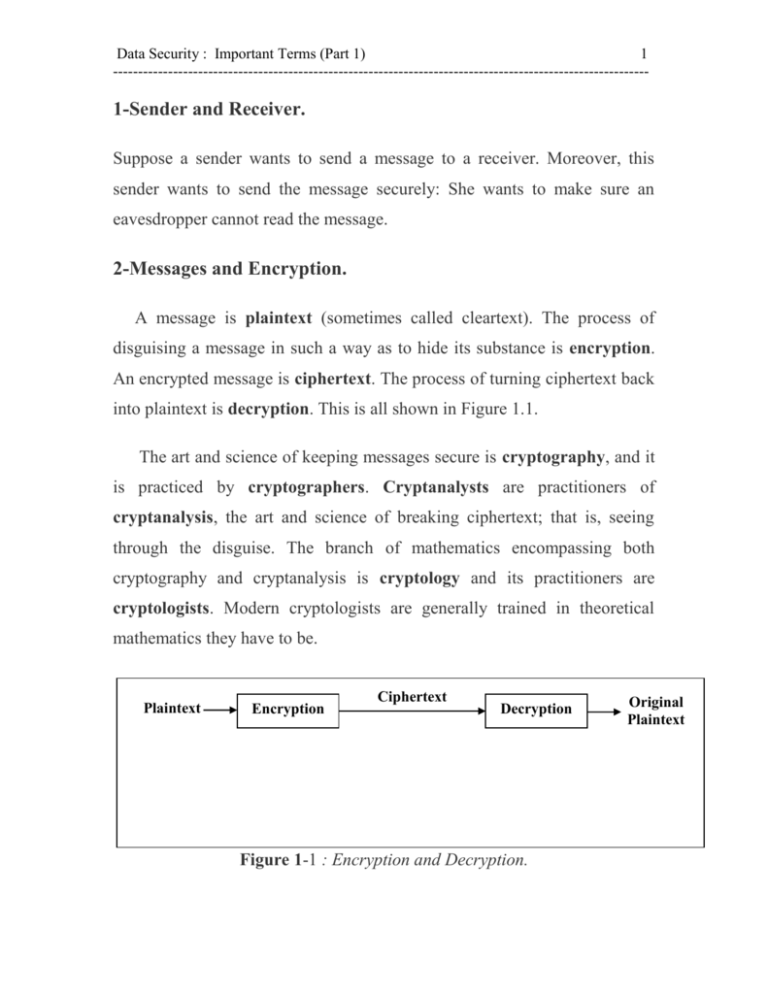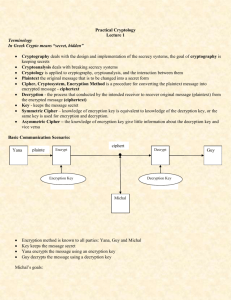eprint_11_12604_49
advertisement

Data Security : Important Terms (Part 1) 1 ----------------------------------------------------------------------------------------------------------- 1-Sender and Receiver. Suppose a sender wants to send a message to a receiver. Moreover, this sender wants to send the message securely: She wants to make sure an eavesdropper cannot read the message. 2-Messages and Encryption. A message is plaintext (sometimes called cleartext). The process of disguising a message in such a way as to hide its substance is encryption. An encrypted message is ciphertext. The process of turning ciphertext back into plaintext is decryption. This is all shown in Figure 1.1. The art and science of keeping messages secure is cryptography, and it is practiced by cryptographers. Cryptanalysts are practitioners of cryptanalysis, the art and science of breaking ciphertext; that is, seeing through the disguise. The branch of mathematics encompassing both cryptography and cryptanalysis is cryptology and its practitioners are cryptologists. Modern cryptologists are generally trained in theoretical mathematics they have to be. Plaintext Encryption Ciphertext Decryption Figure 1-1 : Encryption and Decryption. Original Plaintext Data Security : Important Terms (Part 1) 2 ----------------------------------------------------------------------------------------------------------- Plaintext is denoted by M, for message, or P, for plaintext. It can be a stream of bits, a text file, a bitmap, a stream of digitized voice, a digital video image...whatever. As far as a computer is concerned, M is simply binary data. The plaintext can be intended for either transmission or storage. In any case, M is the message to be encrypted. Ciphertext is denoted by C. It is also binary data: sometimes the same size as M, sometimes larger. (By combining encryption with compression, C may be smaller than M. However, encryption does not accomplish this.) The encryption function E, operates on M to produce C. Or, in mathematical notation: E(M) = C In the reverse process, the decryption function D operates on C to produce M: D(C) = M Since the whole point of encrypting and then decrypting a message is to recover the original plaintext, the following identity must hold true: D(E(M)) = M Data Security : Important Terms (Part 1) 3 ----------------------------------------------------------------------------------------------------------- 3-Authentication, Integrity, and Nonrepudiation. In addition to providing confidentiality, cryptography is often asked to do other jobs: — Authentication. It should be possible for the receiver of a message to ascertain its origin; an intruder should not be able to masquerade as someone else. — Integrity. It should be possible for the receiver of a message to verify that it has not been modified in transit; an intruder should not be able to substitute a false message for a legitimate one. — Nonrepudiation. A sender should not be able to falsely deny later that he sent a message. These are vital requirements for social interaction on computers, and are analogous to face-to-face interactions. That someone is who he says he is...that someone’s credentials whether a driver’s license, a medical degree, or a passport are valid...that a document purporting to come from a person actually came from that person. These are the things that authentication, integrity, and nonrepudiation provide. 4-Algorithms and Keys. A cryptographic algorithm, also called a cipher, is the mathematical function used for encryption and decryption. (Generally, there are two related functions: one for encryption and the other for decryption.) If the security of an algorithm is based on keeping the way that algorithm works a secret, it is a restricted algorithm. Restricted algorithms have Data Security : Important Terms (Part 1) 4 ----------------------------------------------------------------------------------------------------------- historical interest, but are woefully inadequate by today’s standards. A large or changing group of users cannot use them, because every time a user leaves the group everyone else must switch to a different algorithm. If someone accidentally reveals the secret, everyone must change their algorithm. Even more damning, restricted algorithms allow no quality control or standardization. Every group of users must have their own unique algorithm. Such a group can’t use off-the-shelf hardware or software products; an eavesdropper can buy the same product and learn the algorithm. They have to write their own algorithms and implementations. If no one in the group is a good cryptographer, then they won’t know if they have a secure algorithm. Despite these major drawbacks, restricted algorithms are enormously popular for low-security applications. Users either don’t realize or don’t care about the security problems inherent in their system. Modern cryptography solves this problem with a key, denoted by K. This key might be any one of a large number of values. The range of possible values of the key is called the keyspace. Both the encryption and decryption operations use this key (i.e., they are dependent on the key and this fact is denoted by the k subscript), so the functions now become: EK(M) = C DK(C) = M Those functions have the property that (see Figure 1.2): DK(EK(M)) = M Data Security : Important Terms (Part 1) 5 ----------------------------------------------------------------------------------------------------------- Some algorithms use a different encryption key and decryption key (see Figure 1.3). That is, the encryption key, K1, is different from the corresponding decryption key, K2. In this case: EK1(M) = C DK2(C) = M DK2(EK1 (M)) = M All of the security in these algorithms is based in the key (or keys); none is based in the details of the algorithm. This means that the algorithm can be published and analyzed. Products using the algorithm can be mass-produced. It doesn’t matter if an eavesdropper knows your algorithm; if she doesn’t know your particular key, she can’t read your messages. key Plaintext Encryption key Ciphertext Decryption Figure 1-2 : Encryption and decryption with a key. Original Plaintext Data Security : Important Terms (Part 1) 6 ----------------------------------------------------------------------------------------------------------- Encryption key Plaintext Encryption Decryption key Ciphertext Decryption Original Plaintext Figure 1-3 Encryption and decryption with two different keys. A cryptosystem is an algorithm, plus all possible plaintexts, ciphertexts, and keys.





